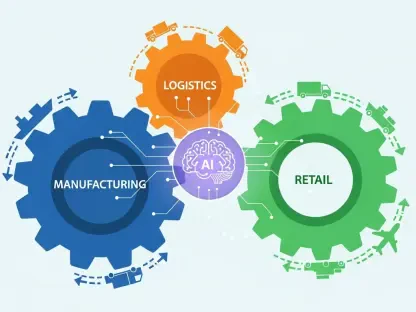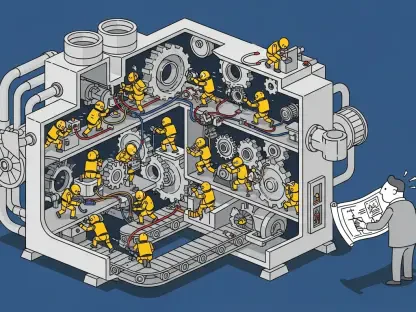In recent years, the Information Technology (IT) landscape has been undergoing significant transformations fueled by the advent of Artificial Intelligence (AI). This evolution is not merely about integrating new technologies but also about reevaluating, redesigning, and rebuilding the fundamental underlying infrastructure. To truly leverage the power of AI, organizations must appreciate that the value it offers is tightly interwoven with IT infrastructure. This necessitates a modernized approach that harmonizes efficiency, security, and innovation. High-Performance Computing (HPC) plays a pivotal role in facilitating AI workloads. Advanced processors, such as Graphics Processing Units (GPUs) and Tensor Processing Units (TPUs), are designed specifically to accelerate AI operations. These specialized processors manage the intensive data processing needs of AI, contributing to more efficient and rapid computation. Without this upgrade, the capacity to run complex algorithms and process massive datasets remains severely restricted.
The Need for Modernization
Legacy systems, often built for human-driven processes, are increasingly acting as bottlenecks, inhibiting resource allocation, productivity, agility, and innovation. These outdated infrastructures struggle to meet the rigorous demands of AI, leading to inefficiencies and limitations in scalability. Consequently, a holistic modernization strategy must be adopted that transcends superficial updates of hardware and software components. Modernization isn’t merely an IT imperative; it’s a business criticality. Organizations need to align their IT infrastructure with AI capabilities to stay competitive. This alignment involves adopting agile frameworks, enhancing storage capabilities, and integrating advanced data processing technologies to ensure seamless operations.
Adopting modern IT infrastructure also opens the door for new AI applications. From predictive analytics and natural language processing to sophisticated machine learning algorithms, the opportunities to innovate and enhance business outcomes are vast. Thus, understanding the inadequacies of older systems prompts a necessary reevaluation and subsequent upgrade. The swiftness with which technology evolves means that businesses relying on legacy systems may soon find themselves at a significant disadvantage. The importance of adopting modern IT infrastructure, therefore, extends beyond technological needs to fundamental business strategy, driving the necessity for organizations to act now, lest they fall behind.
Infrastructure Requirements for AI Workloads
AI operations demand infrastructure capable of handling significant computational workloads. High-Performance Computing (HPC) systems that utilize GPUs and TPUs are vital for managing these intensive processes. These processors significantly boost the speed and efficiency of data processing, which are essential for executing complex AI algorithms quickly and accurately. The increased reliance on data-driven decision-making further emphasizes the need for robust computational capabilities.
The flexibility and scalability of infrastructure are equally critical, given the rapid evolution of AI technologies. Modular infrastructure frameworks offer a solution, enabling easy replacement and adaptation of components to meet changing needs. This modularity enhances both flexibility and cost efficiency, allowing organizations to scale their operations seamlessly as AI technologies advance. Moreover, adopting a modular approach reduces downtime and enhances system resilience. Organizations can upgrade or replace individual components without disrupting the entire system, ensuring continuous business operations. In this context, HPC systems and modular frameworks collectively enable the agile adoption and implementation of AI technologies. The ability to quickly adapt to new technological changes ensures that businesses remain at the forefront of innovation.
The necessity of investing in high-performance and scalable infrastructure cannot be overstated. AI workloads are inherently data-intensive, requiring immense computational power for tasks such as image recognition, natural language processing, and predictive analytics. Therefore, an organization looking to harness AI effectively must prioritize the development of a flexible, scalable, and high-performance infrastructure. This strategic move not only improves current operations but also lays the groundwork for future advancements, preparing the organization to capitalize on emerging AI capabilities as they develop.
The Role of the Cloud
Cloud computing has become indispensable for modern IT infrastructure. Its near-infinite scalability allows organizations to ramp up or down resources as required, addressing fluctuating workloads without compromising performance. By leveraging the cloud, businesses can integrate cutting-edge AI and machine learning capabilities without the burden of heavy upfront expenditures. The cloud offers a level of adaptability that traditional, on-premises infrastructures simply cannot match.
Moreover, the adoption of multi-cloud and hyper-converged infrastructure at the data center level equips organizations with the necessary adaptability. Multi-cloud strategies allow businesses to distribute workloads across multiple cloud platforms, optimizing performance, and reducing the risk of outages. Hyper-converged infrastructure further simplifies management and enhances scalability, making it easier to deploy AI applications. Cloud computing also facilitates collaboration and innovation. By providing a shared platform, teams can develop, test, and deploy AI solutions more efficiently. This collaborative environment fosters innovation, as developers can experiment with new ideas and rapidly bring AI-driven solutions to market. The cloud’s capability to offer a collaborative workspace ensures that organizations can innovate without the constraints often imposed by legacy systems.
Furthermore, the cloud model of infrastructure helps organizations manage costs more effectively. Instead of investing in expensive hardware and managing extensive data centers, businesses can rely on cloud service providers to supply necessary resources. This model offers a more flexible pay-as-you-go pricing scheme, making it easier for companies to scale operations based on demand without excessive financial strain. By effectively leveraging cloud infrastructure, businesses can focus more on driving innovation and less on managing IT logistics.
Security and Compliance Challenges
With the rise of AI, security and compliance have become more critical than ever. AI-powered cybercrimes, such as phishing and ransomware attacks, are becoming increasingly sophisticated, targeting even robustly secure organizations. This escalating threat underscores the need for enhanced security measures, including encryption, access controls, and regular backups.
To counter these threats, employing AI-powered security solutions can add a layer of real-time threat detection and response. These solutions leverage machine learning algorithms to identify and mitigate potential security breaches before they cause significant damage. By integrating AI with security protocols, organizations can enhance their defense mechanisms and protect sensitive data more effectively. As cyber threats evolve, the application of AI in cybersecurity ensures that defenses remain one step ahead, adapting in real-time to new tactics and techniques used by malicious actors.
Equally important is the need for compliance with data protection and privacy laws. Regulatory bodies meticulously monitor how organizations handle data, making it essential for businesses to adopt transparent and well-documented infrastructure practices. Ensuring compliance not only avoids legal pitfalls but also builds user trust, which is critical for maintaining a positive reputation. Non-compliance risks not only heavy fines but also significant damage to a company’s reputation, which could have long-term financial implications. Consequently, the integration of AI into IT infrastructure must be done with careful consideration of legal requirements to safeguard both the company’s interests and its users’ data.
The combined need for strong security protocols and regulatory compliance creates a dual mandate for organizations: they must be vigilant in their defense against cyber threats while also ensuring that their data practices meet all legal standards. Failure in either area could undermine the benefits of modernizing IT infrastructure for AI, making it imperative for organizations to adopt a comprehensive, proactive approach to security and compliance.
Overarching Trends and Consensus
AI operations require infrastructure that can handle significant computational workloads, making High-Performance Computing (HPC) systems with GPUs and TPUs essential. These processors markedly enhance the speed and efficiency of data processing, which is crucial for executing complex AI algorithms swiftly and accurately. The growing dependence on data-driven decision-making highlights the need for strong computational capabilities.
Equally important are the flexibility and scalability of the infrastructure, given how rapidly AI technologies evolve. Modular infrastructure frameworks offer a viable solution, allowing for easy updates and adaptations to meet changing demands. This modularity boosts both flexibility and cost-efficiency, enabling organizations to scale operations smoothly as AI technologies advance. Additionally, a modular approach minimizes downtime and enhances system resilience, as organizations can upgrade or replace individual components without disrupting the entire system.
HPC systems and modular frameworks collectively facilitate the agile adoption and implementation of AI technologies. The capacity to quickly adapt to new technological changes ensures businesses stay at the forefront of innovation.
Investing in high-performance and scalable infrastructure is crucial. AI workloads are inherently data-intensive, requiring significant computational power for tasks like image recognition, natural language processing, and predictive analytics. Therefore, organizations aiming to effectively harness AI must focus on developing a flexible, scalable, and high-performance infrastructure. This strategic focus not only enhances current operations but also prepares the organization for future advancements, enabling them to capitalize on emerging AI capabilities as they arise.









